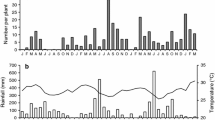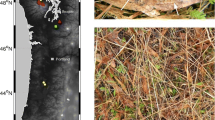Abstract
In the United Kingdom, Panolis flammea (Den. and Schiff.) (Lepidoptera: Noctuidae) is an important pest species of the introduced lodgepole pine but not of its natural host Scots pine. The timing of P. flammea larval growth must be synchronized with its host tree if the larvae are to succeed. We collected field data during 1990 which revealed that the phenological window starts earlier in Scots pine and is shorter than that observed in lodgepole pine. The larvae are found in the field earlier and within a narrower time frame within a Scots pine forest than in a lodgepole pine forest. The larval developmental period is significantly longer on lodgepole pine than on Scots pine. The synchrony/asynchrony of P. flammea to its natural host (Scots pine) and an introduced tree (lodgepole pine) results in the parasitoids having a different impact on the larvae of the two hosts. At any one time, the host plant, caterpillars and parasitoids are more synchronous on the ancestral Scots pine than on lodgepole pine, resulting in a higher percentage of larvae in the optimal instar for parasitism at that time. In lodgepole pine, the percentage of suitable instars available to parasitoids is lower at any given time. The information presented here furthers our understanding of the possible mechanisms for the observed differential population dynamics of the insect on Scots pine and lodgepole pine in the UK.




Similar content being viewed by others
References
Aegerter JN (1997) A three tropic level interaction: the influence of the host plant (lodgepole pine, Pinus contorta, Douglas), on the vulnerability of a herbivore (pine beauty moth, Panolis flammea, to its parasitoids. Unpublished PhD thesis. University of York, York, UK
Crawley MJ, Akhteruzzaman M (1988) Individual variation in the phenology of oak trees and its consequences for herbivorous insects. Funct Ecol 2:409–415
Füldner K, Franken F (2001) Survival potential of the L1-caterpillar of the pine beauty moth (Panolis flammea Linnaeus, 1758: Lepidoptera, Noctuidae) on may-shoots and mature needle of Scotch pine (Pinus sylvestris). Allgemeine Forst Jagdzeitung 172:21–26
Harrington R, Woiwod I, Sparks T (1999) Climate change and trophic interactions. Trends Ecol Evol 14:146–150
Hicks BJ, Barbour DA, Evans HF, Heritage S, Leather SR, Milne R, Watt AD (2001a) The history and control of the pine beauty moth, Panolis flammea (D. and S.), (Lepidoptera: Noctuidae) in Scotland from 1976 to 2000. Agric For Entomol 3:161–168
Hicks BJ, Barbour DA, Cosens D, Watt AD (2001b) The influence of weather on populations of the pine beauty moth and its fungal diseases in Scotland. Scott For 55:199–207
Hicks BJ, Mckenzie F, Cosens D, Watt AD (2003) Harvestmen abundance and diversity within lodgepole and Scots pine plantations of Scotland and their impact on pine beauty moth populations. For Ecol Manage 182:355–361
Hicks BJ, Aegerter JN, Leather SR, Watt AD (2007) Differential rate of parasitism of the pine beauty moth (Panolis flammea) depends on host tree species. Scott For 61:5–10
Hunter MD (1990) Differential susceptibility to variable plant phenology and its role in competition between two insect herbivores on oaks. Ecol Entomol 15:401–408
Jones BC, Despland E (2006) Effects of synchronization with host plant phenology occur early in the larval development of a spring folivore. Can J Zool 84:628–633
Leather SR (1994) The effect of temperature on oviposition, fecundity and egg hatch in the pine beauty moth, Panolis flammea (Lepidoptera: Noctuidae). Bull Entomol Res 84:515–520
Leather SR, Brotherton CM (1987) Defensive responses of the pine beauty moth, Panolis flammea (D and S) (Lepidoptera: Noctuidae). Entomol Gaz 38:19-24
Leather SR, Walsh PJ (1993) Sub-lethal plant defences: the paradox remains. Oecologia 93:153–155
Leather SR, Beare JA, Cooke RCA, Fellowes MDE (1998) Are differences in life history parameters of the pine beauty moth shape Panolis flammea modified by host plant quality or gender? Entomol Exp Appl 87:237–243
Mopper S, Simberloff D (1995) Differential herbivory in an oak population: the role of plant phenology and insect performance. Ecology 76:1233–1241
Parry D, Spence JR, Volney WJA (1998) Bud break phenology and natural enemies mediate survival of first-instar forest tent caterpillar (Lepidoptera: Lasiocampidae). Environ Entomol 27:1369–1374
Speight MR, Hunter MR, Watt AD (1999) Ecology of insects: concepts and applications. Blackwell Scientific, Oxford
Van Asch M, Visser ME (2007) Phenology of forest caterpillars and their host trees: the importance of synchrony. Ann Rev Entomol 52:37–55
Vanbergen AJ, Hodgson DJ, Thurlow M, Hartley SE, Watt AD (2003) Food-plant effects on larval performance do not translate into differences in fitness between populations of Panolis flammea (Lepidoptera: Noctuidae). Bull Entomol Res 93:553–559
Watt AD (1987a) The effect of shoot growth stage of Pinus contorta and Pinus sylvestris on the growth and survival of Panolis flammea larvae. Oecologia 72:429–433
Watt AD (1987b) Pine beauty moth outbreaks: the influence of host species, plant phenology, soil type, plant stress and natural enemies. In: Leather SR, Stoakley JT, Evans HF (eds) Population biology and control of the pine beauty moth. Forestry Commission Bulletin 67. HMSO, London, pp 21–26
Watt AD (1989) The chemical composition of pine foliage in relation to the population dynamics of the pine beauty moth, Panolis flammea, in Scotland. Oecologia 78:251–258
Watt AD, Hicks BJ (2000) A reappraisal of the population dynamics of the pine beauty moth, Panolis flammea, on lodgepole pine, Pinus contorta, in Scotland. Popul Ecol 42:225–230
Watt AD, Leather SR (1988a) The pine beauty in Scottish lodgepole pine plantations. In: Berryman AA (ed) Dynamics of forest insect populations: patterns, causes, implications, Plenum Press, New York, pp 243–266
Watt AD, Leather SR (1988b) The impact and ecology of the pine beauty moth in upland pine forests. In: Usher MB, Thompson DBA (eds) Ecological change in the uplands. Blackwell Scientific, Oxford, pp 261–272
Watt AD, McFarlane AM (2002) Will climate change have a different impact on different trophic levels? Phenological development of winter moth Operoptera brumata and its host plants. Ecol Entomol 27:254–256
Watt AD, Leather SR, Forest GI (1991) The effect of previous defoliation of pole-stage lodgepole pine on plant chemistry, and on the growth and survival of pine beauty moth (Panolis flammea) larvae. Oecologia 86:31–35
Zwölfer W (1931) Studen zur Ökologie und Epidemiologie der Inseckten. 1. Die Kieferneule, Panolis flammea Sciff. Z Angew Entomol 17:475–562
Acknowledgements
We thank Paddy Walsh for his help with some of the field work. The Forestry Commission provided much financial support, vehicles and access to their plantations. This work was supported by a NERC/CASE studentship to J. Aegerter.
Author information
Authors and Affiliations
Corresponding author
Additional information
Handling editor: Robert Glinwood.
Rights and permissions
About this article
Cite this article
Hicks, B.J., Aegerter, J.N., Leather, S.R. et al. Asynchrony in larval development of the pine beauty moth, Panolis flammea, on an introduced host plant may affect parasitoid efficacy. Arthropod-Plant Interactions 1, 213–220 (2007). https://doi.org/10.1007/s11829-007-9024-1
Received:
Accepted:
Published:
Issue Date:
DOI: https://doi.org/10.1007/s11829-007-9024-1




